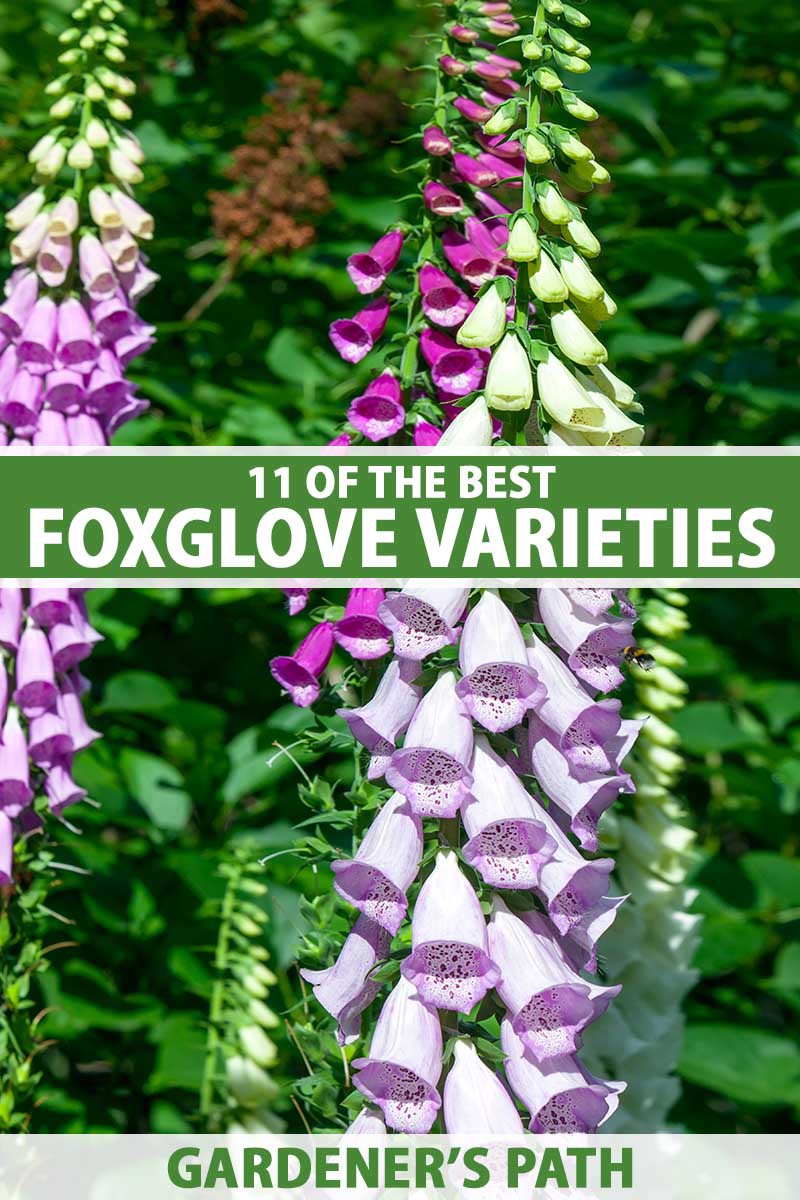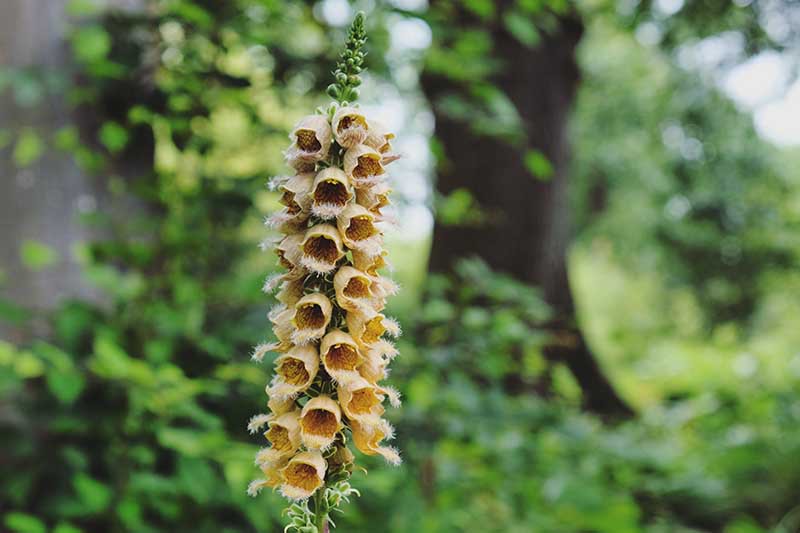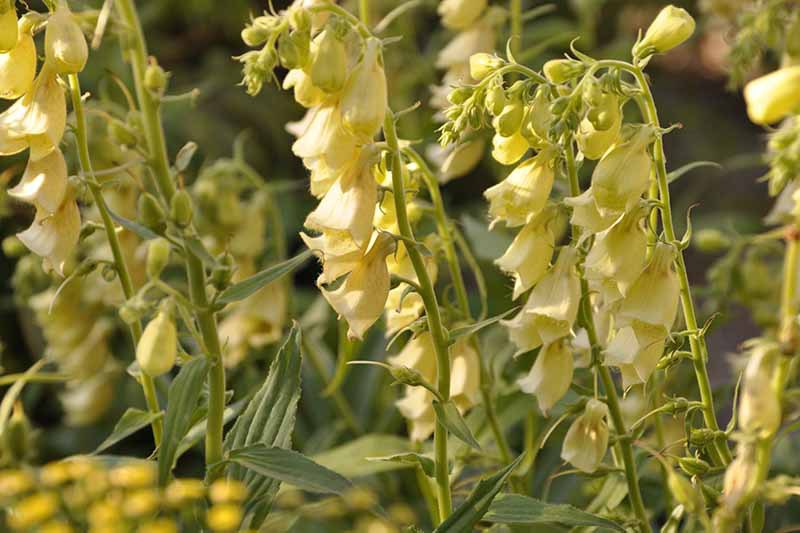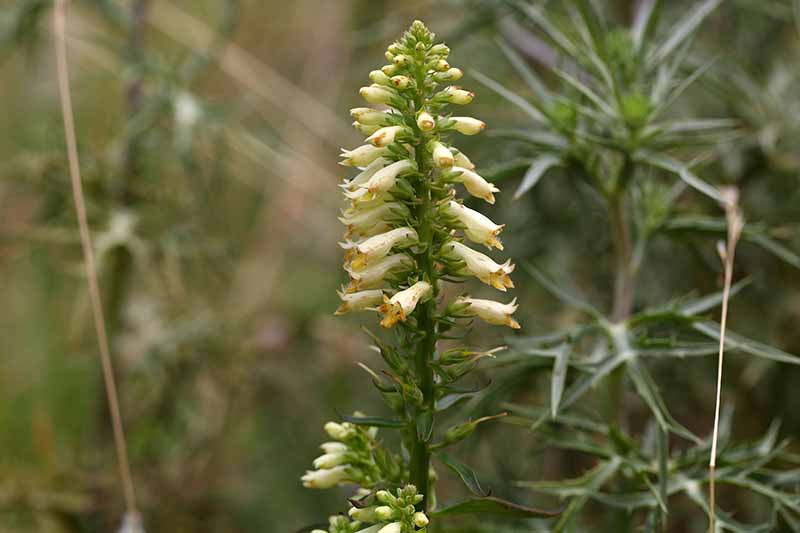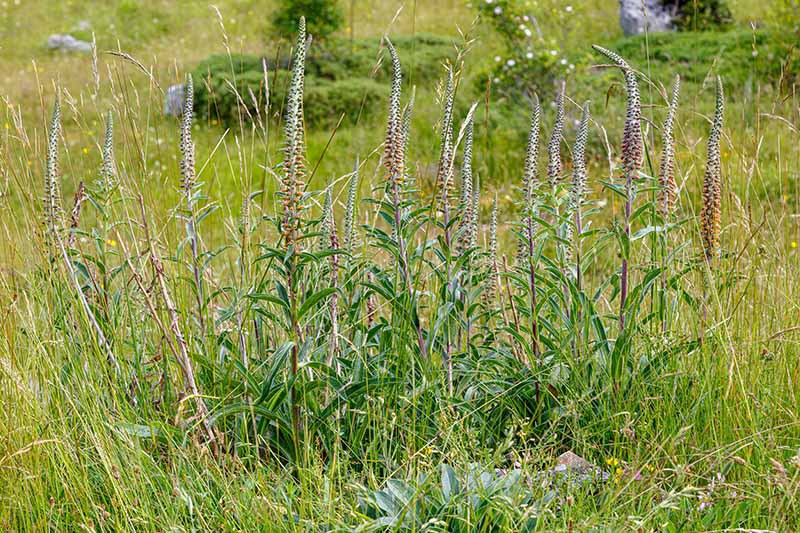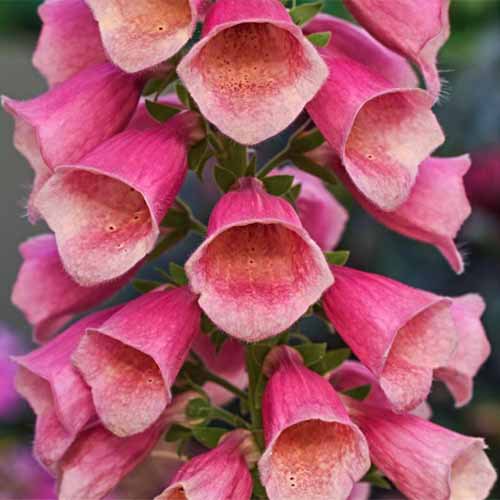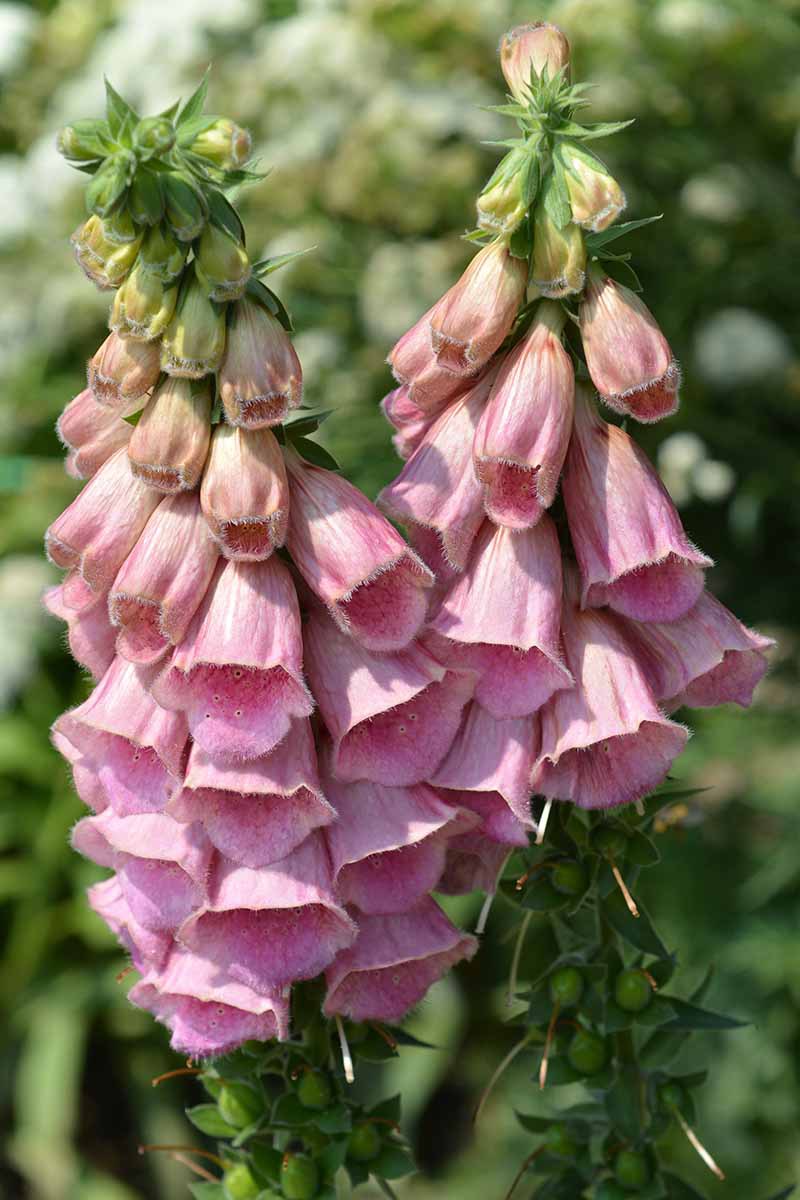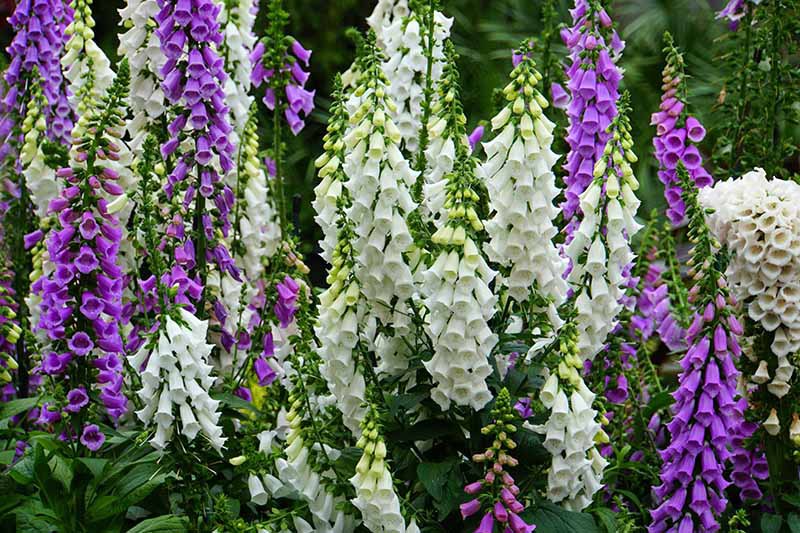The common foxglove, Digitalis purpurea, is the most well-known species. Also called “lady’s glove,” it’s been cultivated from and hybridized with other Digitalis species to create a wide selection of varieties that are perfect for any garden. We link to vendors to help you find relevant products. If you buy from one of our links, we may earn a commission. Consider planting it in an enclosed area. Or, save this article and wait until your kids are older before planting if you have concerns! To learn more about this plant’s history and growing requirements, check out our guide to growing common foxglove. As long as it’s safe for you to grow, D. purpurea and all its related varieties and hybrids make excellent additions to the yard or garden, attracting hummingbirds, butterflies, and bees, and resisting deer and rabbits. To help you get started, we’ve narrowed down the list to 11 fantastic selections. Are you ready to explore our top picks? Let’s go!
A Word About Species
D. purpurea is the most common foxglove you’ll see in gardens. But there are a few additional species to know about, especially since some of them have likely been crossed with D. purpurea to create some of the cultivars we’ll discuss below. Here are four additional garden-favorite Digitalis species to familiarize yourself with:
D. ferruginea
This species features cream-colored flowers with mouths shaped like an “O.” Often called “rusty foxglove,” due to the rusty splotches you’ll find inside the throats of each blossom, D. ferruginea is hardy in Zones 4 to 8 and grows three to five feet tall, with a spread of 12 to 18 inches. Flowers bloom from May to June, and are three-quarters to one and a half inches long.
D. grandiflora
This species, which features elongated yellow flowers with star-shaped openings, is commonly referred to as “large yellow foxglove.” D. grandiflora is hardy in Zones 3 to 8, grows two to three feet tall, and spreads 12 to 18 inches. Blooming from May to June, flowers are about two inches long.
D. lutea
This is a dainty, light yellow species with two common names: “straw foxglove,” and “small yellow foxglove.” Hardy in Zones 3 to 9, it grows two to three feet tall and spreads about one foot, but the flowers are small at just half an inch to one and a half inches long. D. lutea blooms from late spring to early summer, typically in June and July.
D. parviflora
Also known as “milk chocolate foxglove,” this species has peculiar two-inch-long orange-brown flowers with narrow, roughly square openings. It grows up to about two feet tall with a spread of one foot, and is hardy in Zones 4 to 8. Now that you know a bit about the species you’re the most likely to see, let’s get on with the best part! Without further ado, here are our favorite foxglove varieties for your garden. If you do, too, look no further than ‘Alba’ (D. purpurea f. albiflora). With two- to three-inch-long cream-white blooms, sometimes with purple-speckled throats, graceful ‘Alba’ is sure to please. ‘Alba’ has been in cultivation since at least 1737, when London gardener Peter Collinson described the variety for the first time that we know of, in a letter to his fellow gardener and friend John Custis of Williamsburg, Virginia. According to E. G. Swemm, director emeritus of the College of William and Mary library, in a 1949 article for the American Antiquarian Society of Worcester, Massachusetts, Collinson wrote of a flower with stalks, “full of white long hollow blossoms,” which he referred to as the “White Fox Glove.” ‘Alba’ It’s the same alluring variety that’s grown in gardens today. Blooming from May to June, the spikes grow three to five feet tall with a spread of one and a half to two feet. These tall, evergreen, biennial beauties are hardy in Zones 4 to 8. You can find seeds in a variety of package sizes available from Eden Brothers.
2. Arctic Fox Rose
If flowers in bright blushes of pink set your heart aflutter, you’ll adore ‘Arctic Fox Rose.’ Reaching just 18 to 24 inches tall with a spread of 16 to 18 inches, this hybrid is a little bit smaller than some of its sisters, but it’s no less of a showstopper. Bred by Darwin Perennials, ‘Arctic Fox Rose’ blooms in the first year from an unrooted cutting and is a true perennial, thriving year after year to follow. The soft pink, one- to two-inch-long flowers feature peach-colored, lightly speckled throats. Hardy in Zones 5 to 9, these beauties bloom from April to September. ‘Arctic Fox Rose’ They’ll make you want to sit and sigh and stare, and forget about the cares of the world for a moment. Get a head start on your garden by purchasing young ‘Arctic Fox Rose’ plants online from Home Depot.
3. Apricot Beauty
This breathtaking cultivar blooms in vivid apricot and then fades to a lighter color with age, which makes for a sensational ombré of color as the stalk blooms from the bottom up. With a mature height of three to five feet and a spread of one and a half to two feet, ‘Apricot Beauty’ takes up a good amount of space in your flower garden – and lovers of this variety wouldn’t have it any other way. ‘Apricot Beauty’ Hardy in Zones 4 to 8, ‘Apricot Beauty’ is a semi-evergreen biennial that blooms from May to June or early July. It’s also described as ‘Sutton’s Apricot’ in some seed catalogs. Flowers are two to three inches long. Find bulk packages or one-ounce packets of seeds available at Eden Brothers.
4. Candy Mountain
If you love foxgloves but wish the flowers would look up at you instead of pointing down toward the ground, ‘Candy Mountain’ is your girl. The soft pink, two- to three-inch-long flowers face up, making their lovely, maroon-speckled throats easy to gaze at. Plus, the speckles are ringed in white, adding texture and color to your flower garden. ‘Candy Mountain’ is a semi-evergreen biennial that blooms in midsummer, grows up to a whopping four feet tall, and spreads one to two feet. ‘Candy Mountain’ It’s hardy in Zones 4 to 9, and you can buy plants in quart-sized containers from Nature Hills Nursery.
5. Camelot Lavender
Camelot is one of the most popular Digitalis hybrid series around, especially in the south where it’s grown as a cool-season annual that blooms well into May or June. A semi-evergreen biennial originally introduced in 2003, it comes in four colors: ‘Rose,’ ‘Cream,’ ‘White,’ and our girl, ‘Lavender.’ For all the purple-lovers out there, of which I am one, ‘Lavender’ is dreamy. With light purple two- to three-inch flared flowers that open to reveal maroon-speckled throats, Camelot ‘Lavender’ looks amazing in a cottage garden, or in a flower bed where it can contrast nicely with your gray, yellow, or red house. ‘Camelot Lavender’ This variety blooms in early to midsummer, is hardy in Zones 4 to 9, and grows up to four feet tall with a spread of one to two feet. You can find young plants in #1 containers available from Nature Hills Nursery.
6. Dalmatian Purple
Do you love shades of purple so delicate they seem almost unreal? Then you’ll adore ‘Purple’ from the Dalmatian series. It has light rose-colored, purple-tinted flowers with lots of light speckles, and each tubular bloom grows up to three inches long. The Dalmatian series was bred to bloom in the first year, about ten weeks after germination, and is hardy in Zones 5 to 9. Other colors include ‘Peach’ and ‘Creme.’ Blooming in early summer, Dalmatian ‘Purple’ is an excellent biennial, semi-evergreen, and semi-compact variety that’s suited to growing in large containers. Dalmatian ‘Purple’ It reaches just one and a half to two feet in height, and spreads only eight to 12 inches. In short, Dalmatian ‘Purple’ aims to please. Plants in one-gallon containers are available from Nature Hills Nursery.
7. Excelsior
A unique hybrid, ‘Excelsior’ is just about always sold as a mix. And it’s easy to see why: with flowers in a range of colors from light pink to purple-pink to peach, a mixed stand of these foxgloves is a breathtaking sight. Each spike is densely packed with blooms that face levelly outward, showing the world their daintily speckled throats. ‘Excelsior’ A semi-evergreen biennial, ‘Excelsior Hybrid’ is hardy in Zones 4 through 8, grows up to 60 inches tall, and spreads 18 to 24 inches. This striking hybrid blooms from June to July, and you can find seed packets with a mix of ‘Excelsior Hybrid’ colors available at Eden Brothers.
8. Foxy
If you’re short on space, ‘Foxy’ is the cunning semi-dwarf mix you’re looking for. The different colors in this mix – cream, lavender, rose, yellow, and white – can create a stunning garden all by themselves. But if you want to grow them in containers, that’s fine too. ‘Foxy’ Semi-compact ‘Foxy’ plants grow to between two and three feet tall with a spread of one foot. The flowers grow to about three inches long. These semi-evergreen biennials are hardy in Zones 5 to 9, and you can find a seed packet with a mix of all the colors available from Eden Brothers.
9. Illumination Flame
Want to try a fascinating cultivar that’ll set your garden aflame with pink and orange hues? Try Digiplexis ‘Illumination Flame,’ a cross between D. purpurea and D. canariensis (syn.Isoplexis canariensis) native to the Canary Islands. Charles Valin of the UK-based Thompson & Morgan seed and plant company first dreamed up and then carried out this breeding venture, and we should all be thankful. ‘Illumination Flame’ has another unique feature: its tubular three- to four-inch flowers stick straight out off the spikes, not pointing up or down, and the blooms are narrower and flatter than usual, resulting in a futuristic effect. ‘Illumination Flame’ These sterile plants grow up to three feet high with a spread of one to two feet. Hardy in Zones 8 to 10, they’re evergreen and will produce blooms all summer long. You can find plants available at Burpee.
10. Polkadot Princess
If you love foxglove spikes densely packed with large, three- to four-inch-long pink blooms, Polkadot ‘Princess’ is an ideal hybrid for you. Part of the Polkadot series, along with ‘Pippa’ and ‘Polly,’ this hybrid grows up to two and a half feet tall and spreads about two feet wide. ‘Polkadot Princess’ A semi-evergreen biennial, Polkadot ‘Princess’ blooms from early spring to early summer, and is hardy in Zones 4 to 8. Find young plants online available from Burpee.
11. Strawberry
For a pleasing cross of D. grandiflora and D. purpurea, now referred to botanically as D. x mertonensis, try ‘Strawberry,’ whose berry-pink color will make your mouth water. (But don’t eat the flowers, remember? They’re highly toxic. Get real strawberries to plant instead!) The bell-shaped, two- to three-inch flowers bloom from late spring to early summer. ‘Strawberry’ is a semi-evergreen, short-lived perennial that’s hardy in Zones 4 to 8. Growing two to three feet high with a spread of one to two feet, ‘Strawberry’ is an excellent choice for the foxglove garden you’re gearing up to grow (because you totally are, right?). Keep in mind that in some nurseries, both brick and mortar and online, ‘Strawberry’ is also known as ‘Summer King.’
Dainty and Delightful
No matter which variety you choose, if you plant foxgloves, you’re bound to experience a deep sense of joy every spring. While many of the above-listed varieties are biennial, D. purpurea reseeds generously, so let the flowers dry and the seeds fly. Just keep in mind that hybrids don’t typically grow true, so results aren’t guaranteed. Learn more about harvesting and saving foxglove seeds. What’s your favorite variety of foxglove? Let us know in the comments below, and share any thoughts or questions you have!And for more information about growing flowers in your garden, check out these guides next:
How to Grow and Care for Summer Snapdragon FlowersHow to Grow and Care for Lovely Larkspur19 Dazzling Delphiniums For Your Flower Beds
